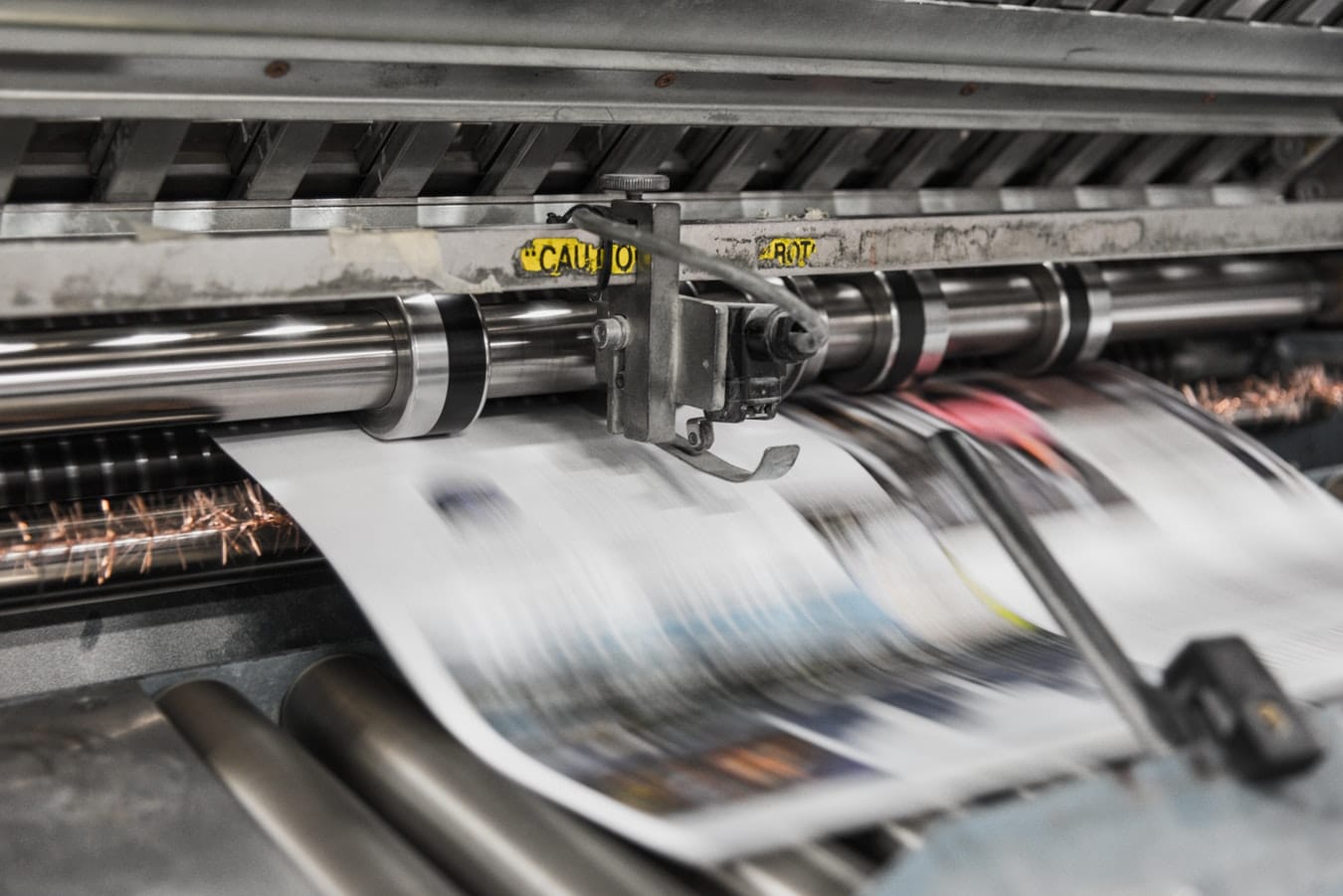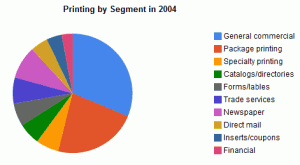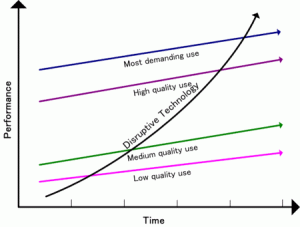Printing is a gigantic industry. It employs about 1 million people in the USA, in contrast to the approximately 800,000 working in the automobile industry. It is a slow-growing, traditional industry.
When counted by number of pages printed, most printing still takes place on printing presses like the one on the right.
The following table and pie chart, based on numbers from an American Printer article , show the state of the US printing industry in 2004.
| Segment | Size ($US billion) |
| General commercial | 53 |
| Package printing | 38 |
| Specialty printing | 10.5 |
| Catalogs/directories | 10 |
| Forms/labels | 10.5 |
| Trade services | 12 |
| Newspaper | 15 |
| Direct mail | 8 |
| Inserts/coupons | 7 |
| Financial | 5 |
Within this slow-moving industry, there have been dynamic pockets of rapid growth and the adoption of modern technologies for the last 25 years. One of these has been digital printing .
I started working in digital printing in the early 1990s. Like many people, my involvement in printing can be traced back to Chester Carlson . My first printing job was at a company that connected computers with high quality Xerographic (Carlson’s invention) digital printers and printed using PostScript (a printing language that was invented by John Warnock and Charles Geshke based on their work at Xerox’s PARC ).
My employer was one of many small companies thriving in the market opened by the cheap Apple LaserWriter PostScript laser printer in 1985 and the cheap desktop publishing applications created by Apple, Adobe and other development companies.
This market remains vibrant as work that was previously done in other parts of the printing industry moves to digital color printing and more corporate printing moves in house as office printers and office software becomes more capable. (There was a parallel and related trend of growth built around home computer printing and drop on demand (dod) inkjet technology but this post will focus on graphics and office printing.) A brief history of digital printing follows.
25 years of digital printing
- 1985. Office laser printer s become available with high quality text and graphics. One of these is the Apple LaserWriter, a PostScript laser printer. HP LaserJet is introduced around the same time and uses the same Canon engine as the LaserWriter but a different page description language PCL. Laser printers and OEMing of print engines and controllers remain hallmarks of the industry for years to come.
- 1985-1990. Adobe , founded in 1982, increase their graphics software for the Macintosh with PhotoShop and Illustrator. PageMaker and Quark Express bring in the desktop publishing revolution. These PostScript based systems along with cheap high quality PostScript Type 1 fonts allow Mac users to compete with graphics houses.
- Early 1990s. The Canon CLC 500 high quality color laser printer with a computer interface that was introduced in 1989 becomes widely available in the USA and Europe. Several 3rd party companies developed interfaces to the CLC500 making higher quality output available to Mac users reducing costs of printing a page dramatically.
- Early 1990s. Small shops with digital printers proliferate and compete with traditional printers and photo labs. Some are ex-copy shops, notably Kinko’s in the USA. Others are just people with some desktop publishing software and a color laser printer.
- 1991. Xerox DocuTech , a high-speed high duty-cycle black and white digital laser printer, explodes on the market and redefines corporate printing. For the first time, manuals can be stored digitally and printed on demand in volume.
- 1995. Windows NT 3.51 is introduced. It is the first Microsoft operating system to have a substantial printing architecture with support for AppleTalk, LPR and SMB printing. Network Digital printing becomes easy.
- Mid 1990s. Xerox Majestik offers comparable image quality and color to Canon CLC range and the color laser printing market becomes competitive.
- 1999. Xerox DocuColor 1250 improves color and image quality in a 12 ppm copier/printer. Xerox DocuColor 4040 is a 40 ppm color printer with high duty cycle that takes market share from traditional printing. Like the Majestik family the 1250 and 4040 are designed and manufactured by Fuji Xerox for Xerox.
- Late 1990s through 2010. Ricoh, Konica Minolta and other printer vendors make color laser printers at lower prices that are increasingly competitive with Canon and Xerox.
- 2008. Monolithic inkjet technology threatens to replace laser printing. HP’s Edgeline and Silverbrook Research’s Memjet look like the first serious contenders to laser printing’s dominance of high workload digital printing but as on today there have been no successful products based on this.
Digital printing industry trends
So what does all this mean? I believe there have been 4 prevailing themes in the digital printing industry:
- The continued dominance of laser printing for heavy duty work. Drop on demand ink jet has done well in home printing but has always had a high consumables cost. High throughput dod ink jet has been limited to expensive high-end applications like large format printing.
- A movement from black and white to color. This has been part of a trend to higher image quality and includes a movement to wider color gamuts, increased resolution and a lot of detail work that keeps image scientists busy refining the venerable Xerographic process beyond what it was originally thought capable of.
- A movement from hardware to software. Graphics and desktop publishing software, network printing software and, less obviously, the software inside printers
- Most, but not all, dominant technologies have started cheap and worked their way up to compete with more expensive existing technologies. This has been true of
- desktop publishing replacing traditional prepress work comprising teams of trained graphic artists and layout specialists and editors
- color digital presses replacing imagesetters and traditional presses
- cheap digital printers taking low-end market share from high-end digital presses
- Mac based desktop publishing moving to Microsoft Office.
This is recognizable as the behavior of industries described in the Innovator’s Dilemma (see graph at right). Companies were not disappearing as in the dramatic cases in the Innovator’s Dilemma but cheaper solutions were becoming good enough for many users and taking sales from the bottom end of existing product lines.
Digital printing today
It seems that the principle of good enough applies to modern digital printing. Today’s low-end digital printers produce elegant output. This is possibly not good enough for the experts but more than adequate for most people. At the same time eBooks are growing in popularity with the iPad being a bigger seller for Apple today than the LaserWriter was 25 years ago.
It is possible that monolithic ink jets will replace laser printers or laser printers may continue to improve and see off competitive technologies as they have for the last 25 years
There seems to a be a movement to services. This often goes under the name of Managed Print Services and is predicated on the proliferation of printers through offices that end up being expensive to maintain. This may amount to a new industry or possibly new software will emerge to do most of the work as it has with all other aspects of digital printing.
If the next 5 years are like the last 15 years then there will be more movement to software and cheaper products will continue to move upwards and replace more expensive products. People want to print less and to reduce costs and help the environment and this is going to be done with software.
PaperCut and digital printing
PaperCut is one of the modern software applications aiming to help organizations print less. PaperCut’s focus is modifying user behavior by applying print policy rules, enforcing quotas, and making users confirm the collection of their print at the device (secure print release), among others.
PaperCut is riding most of the trends described above. It is a disruptive technology, cheaper than its competitors yet meeting the needs of most users. It is software taking the place of hardware, such as coin boxes for copiers. It addresses the same issue of reducing the total cost of printing across organizations as Managed Print Services but with a focus on software rather than services.
PaperCut is also aggressively technologically agnostic across the entire gamut of digital printing technologies supporting laser and inkjet, black and white and color, PostScript and PCL, print, copy, scan and fax on Windows, Mac and Linux print architectures.
References The Press by e-lame Disruptive technology graph by Megapixie Xerography_24 by klaus.urbons








